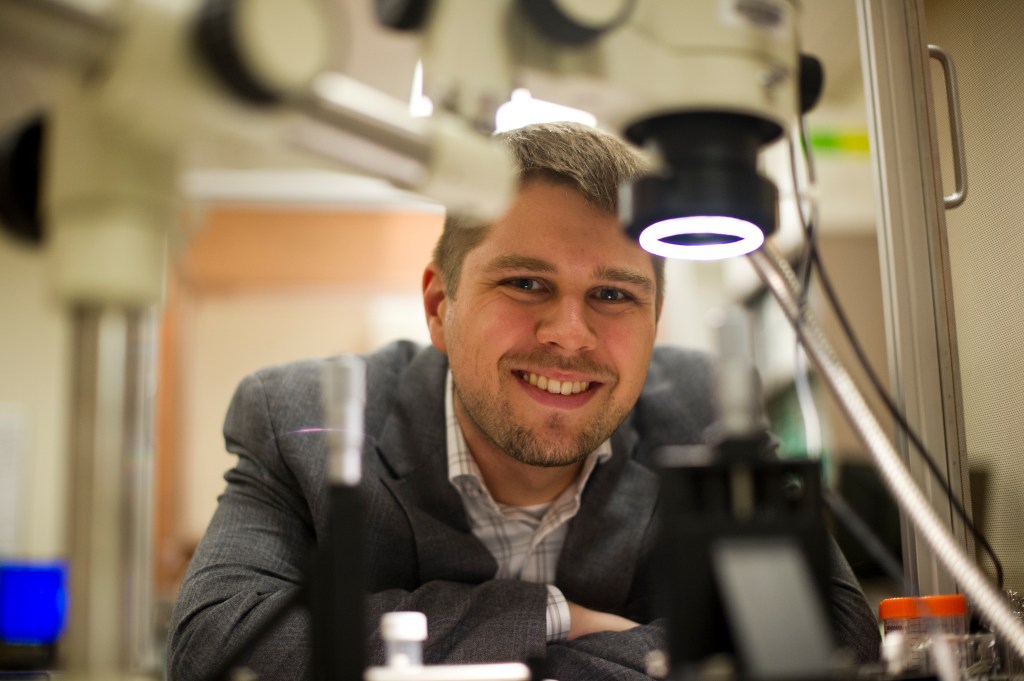Highway of dreams for microbiologists

Bacteria are a pervasive and elusive bunch. Scientists estimate that between 10 million and 1 billion different microbial species populate the world, yet only a handful of them have so far been identified. Why? Because the overwhelming majority of microbes refuse to grow in the laboratory. This is despite decades of scientists’ best efforts at coaxing the microscopic organisms into action.
Slava Epstein, a biology professor at Northeastern University, has dedicated his career to coming up with alternative methods for cultivating bacteria. His favorite strategy, so to speak, is to take the lab bench into the wild. In nature, bacteria are exposed to a host of nutrients and supportive chemicals that help them grow. But scientists don’t know what they all are. This way, he explained, nature can work its secrets without him having to know what they are. So far, the devices he’s used incorporate permeable membranes that allow sequestered bacteria to be exposed to the nutrients and molecules of their native environment.
But a problem has remained: Natural competition between species, even in the wild, has limited the number of species Epstein can successfully isolate this way. A few years ago he and his collaborator Yoshiteru Aoi at Hiroshima University in Japan began to fantasize about a device that would permit just a single bacterial cell to enter. Once inside, this cell would proliferate as in his other devices, but here it would be free of competition from other species. It would provide a pure sample—just one species.
But creating that fantastical device presented a challenge to the team of biologists. Enter Edgar Goluch, DiPietro assistant professor in the Department of Chemical Engineering at Northeastern. “Without Ed,” Epstein said, “we wouldn’t have been able to do anything.”
Goluch’s lab is focused on creating microfluidic devices for detecting various biological entities, be it a bacterial cell or an enzymatic molecule. In 2012, he and Epstein teamed up to make the fantasy device a reality. With funding from a Tier 1 Interdisciplinary Research Grant form Northeastern’s Office of the Provost, the duo managed to make a series of prototype devices.

The device developed by Goluch’s team consists of an inner food chamber and a microscopic constriction through which only a single bacterial cell can pass. Photo courtesy of Edgar Goluch.
“Think of a five lane highway going down to one lane,” Goluch explained. “That’s essentially what this does only for bacteria.” The tiny device consists of an inner chamber containing a food source, to which the only access is a microscopic passageway just slightly narrower than a single cell.
The passageway is so small that the first cell to enter it gets stuck, blocking entry by any other cell or species. The trapped cell is still able to proliferate, however, and when it does it fills up the inner chamber with a pure, single-species sample. “Whoever gets there first wins and gets all the stuff inside,” Goluch said.
In a paper released Monday in the journal PLOS ONE, the team demonstrates the device’s ability to separate mixtures of cell types. In one experiment, the researchers separated two different bacterial species whose cells are slightly different sizes—E. coli and P. aueruginosa. In a second experiment, they isolated a combination of similarly sized but differently shaped species that commonly show up together in the marine environment—Roseobacter sp. And Pscyhoserpens sp. Finally, they used the device to separate cells of the same species that had been differentially tagged to glow either red or green. This experiment validates the hypothesis that the cells grown inside the food chamber are daughters of the single cell caught in the entryway.
Next week, Epstein will take the prototypes to Greenland for their first taste of real-world experimentation.
In the meantime, funding from an Instrument Development Biological Research Grant from the National Science Foundation will enable Goluch and his team of engineers to begin optimizing the device and its manufacture. Currently, they use a template to lay down the initial architecture and must then drill each individual micrometer-wide hole. But in order for the approach to really work, Epstein and Aoi would need many, many samples.
“We’d like to throw these into any environment on the planet,” Epstein said. “The deep ocean, under the soil, into a pond.” In order to reach that kind of range, Goluch is working with a number of industry partners to streamline and scale the fabrication process.
The benefit will be the same: “It simplifies cultivation to the maximum extent possible,” Epstein said. “We don’t have to do anything, just build the devices and throw them into the environment. Nature does the rest.”





